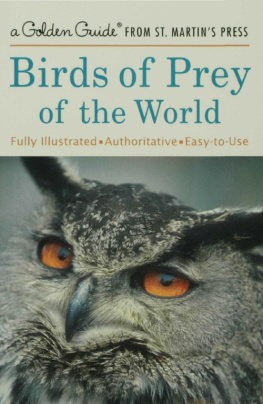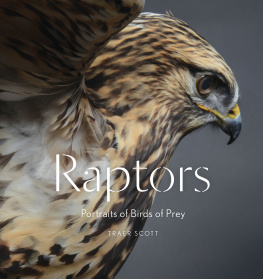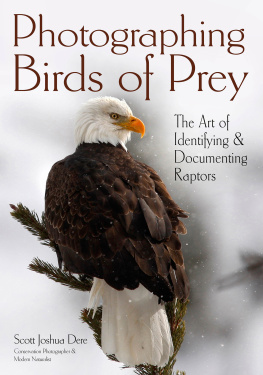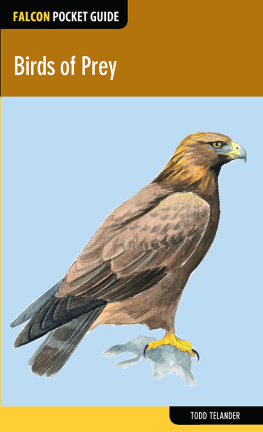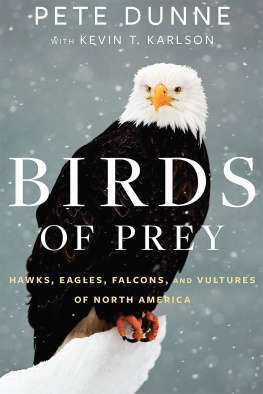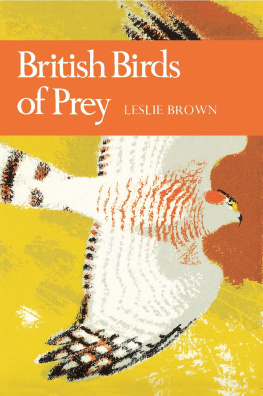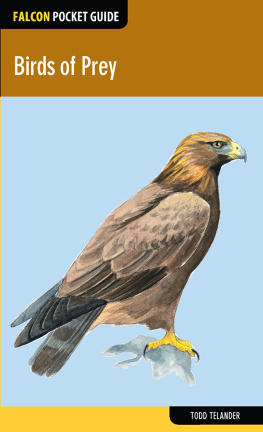BIRDS OF
PREY OF
THE WORLD
a Golden Guide from St. Martins Press
Written by Robin Chittenden
Illustrated by
John Davis/Wildlife Art, Ltd.

The author and publisher have provided this e-book to you for your personal use only. You may not make this e-book publicly available in any way. Copyright infringement is against the law. If you believe the copy of this e-book you are reading infringes on the authors copyright, please notify the publisher at: us.macmillanusa.com/piracy.
FOREWORD
This introductory guide to the fascinating world of birds of prey will help any enthusiast or student understand the diversity and beauty of these dinosaur descendants.
Golden Guides have a tradition of producing beautifully illustrated and well-informed nature guides, and Birds of Prey continues this tradition. Key species from every family have been selected, from the smallest Forest Falconet to the largest Eagle Owl. Interesting behavioral information, vital statistics, and ranges have also been included.
Special thanks must go to the artist, John Davis, for creating such excellent illustrations. He has managed to breathe life into these awe-inspiring birds.
I would also like to thank my partner, Olivia Lepri, for her patience and understanding while I took time out to write this book.
WHAT IS A BIRD OF PREY?
Birds of prey, or raptors, are the only survivors from the time when huge meat-eating dinosaurs stalked the world. They are thought to be smaller relatives of these giants, evolving feathers and other characteristics that have enabled them to flourish right up to the present day. A raptor is a bird that has a preference for eating meat, whether dead or alive, although some species eat a lot of fruit. The term raptor comes from the Latin verb rapio, which means to seize, snatch, or tear away. Things that are raptorial are adapted for snatching or robbing. Birds of prey have been divided into groups (see ) and include hawks, kites, eagles, harriers, falcons, and vultures, which normally hunt during daylight hours, and owls, which usually hunt during the hours of darkness (nocturnal) or at dawn or dusk (crepuscular).
Raptors that have to kill and eat meat have evolved into efficient catching and dispatching machines. They have fantastic eyesight and some have a powerful sense of smell, used to locate prey. They all have hooked bills and curled talons for grabbing, killing, and cutting up their victims.
Many species of raptor are very territorial, ensuring that they have a large enough area of land to sustain them. Others, however, are more nomadic, hunting out high concentrations of food, such as swarming locusts.
Immature birds of prey are usually browner than their parents, which may reduce the chance of the adults accidentally attacking their young in the belief that they are potential contenders for their territory. The male is often smaller than the female, a phenomenon known as reversed sexual size dimorphism. If there is a plumage difference, the male is usually more brightly colored.
Large raptors tend to get up rather late in the day in order to use the uplifting power of thermals so that it takes less energy to fly. Some can avoid flapping for hours.
Most birds of prey are monogamous, but there are a few exceptions, such as harriers, which may have several partners. Often, the same pair of raptors will return to the same breeding site and they may even migrate together. Certain species nest colonially, although some may only do this if there is a limited number of breeding sites or if their food sources are localized.
Raptors have cultural significance. In times gone by, they were important to the ancient Egyptian, Aztec, and Mayan cultures. Today, eagles and falcons are used by some businesses in their marketing strategy, reflecting the buying publics perception of the raptors power and strength. Parts of some raptors are constituents in the ingredients of traditional medicines in Africa, the Caribbean, and China. Falcons have been trained to hunt for food by man for over 2,000 years, often resulting in the protection of the species to ensure a plentiful supply of birds for the falconers. In the developed world, raptors have been persecuted for various reasons for the past 300 years, a practice encouraged by bounties. In more recent times, habitat destruction, and pollutants have taken their toll. Despite this, only the Guadalupe Caracara has become extinct in recent times, although others are perilously close to dying out.
HEADS
Many raptors have a crest, while others have a white base to the crown feathers, which are raised when the bird is scared or concerned. Some have markings on the back of the head that resemble another pair of eyes, perhaps to confuse other predators. Falcons have bony baffles in their nostrils, which may help in reducing airflow through them during high-speed stoops. Some diving raptors have slit-shaped nostrils to reduce the entry of water. The ear openings are just behind and below the eyes and only visible on raptors with exposed head skin, such as vultures. Owls, and to a lesser extent harriers, have a flat face or facial disk that helps channel sound to their ear openings.
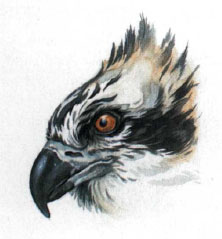
Because the Osprey hunts by plunging into water, its nostrils are slit-shaped and more horizontal than other raptors.
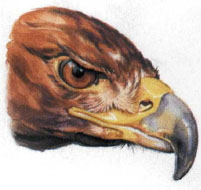
The Golden Eagle has larger nostrils as they dont need to keep out water.
EYES AND EYESIGHT
The eyes of diurnal raptors are set on either side of the head, facing forward. An upper and lower eyelid and a nictitating membrane protect the eye. Some species have a bony ridge above and to the front of the eye, which both protects and shades the eye. In owls, the eyes are situated at the front of the head and diverge outward slightly.
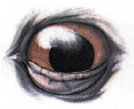
Lower eyelid
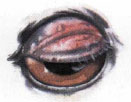
Upper eyelid
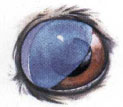
Nictitating membrane
The eyesight of birds of prey is between four and eight times better than that of humans. When scanning into the distance they can see eight to ten times farther than man. Some raptors can spot a grasshopper at 109 yards (100 m) and others can detect a vole or lizard at 437 yards (400 m) and a rabbit at 0.62 mile (1 km). Many owls hunt after nightfall, and although some use their exceptional hearing abilities to locate and catch prey, their eyesight in darkness is between 10 and 100 times better than mans.
BILL SHAPES
The bill is strong and hooked and is used for ripping up flesh into smaller, gulpable pieces. The sharp edges of the bill act like knives to slice through flesh. With the prey securely clamped under its feet, the raptor can pull off chunks of flesh by burying its hooked bill in the flesh and straining up and backward. Some falcons have a tooth in the upper mandible, used both to kill prey with a bite to the neck, and for taking apart insects. Some kites have two teeth. The birds beak, or bill, is made of bone and covered by horny plates of a tough fibrous material called keratin. Some have huge bills for chopping up large chunks of flesh, whereas others can have quite small ones for picking at little bits of meat. At the base of the upper bill is a soft, fleshy area known as the cere. The absence of feathers below the raptors bill is for hygiene reasons, as they would get caked in blood and would be difficult to clean. Owls have beaks that are relatively small and are not generally used for pulling apart flesh as they tend to eat prey whole.

